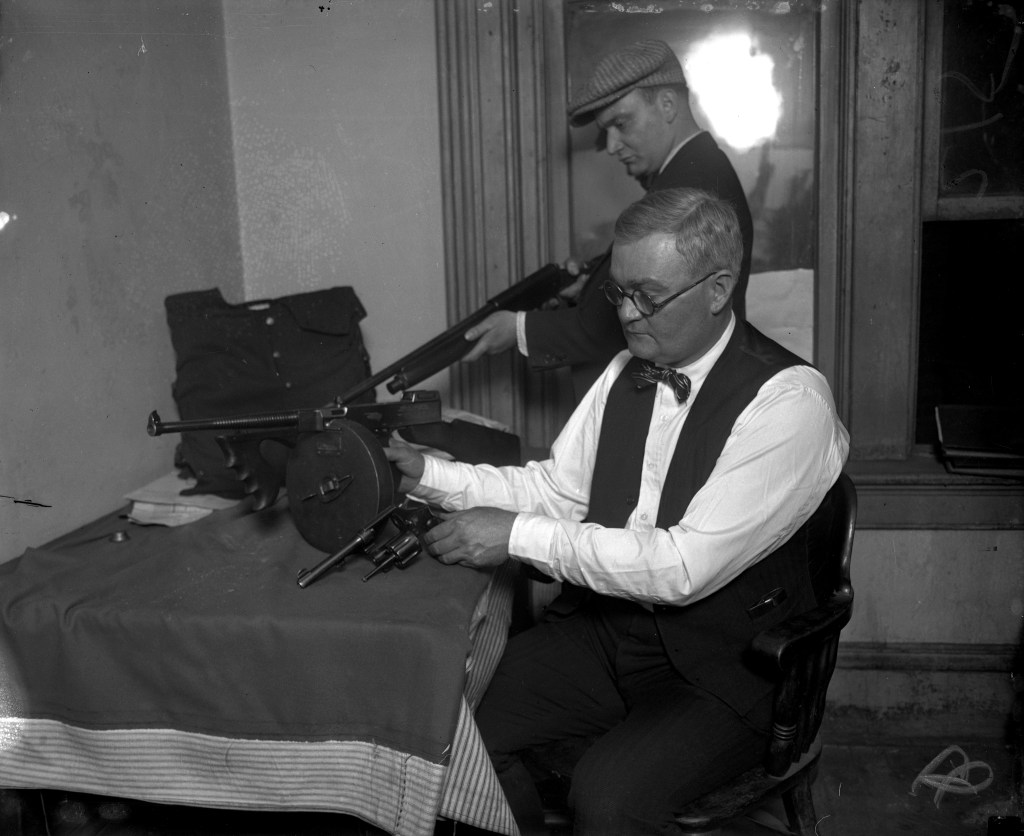Here’s a look back at what happened in the Chicago area on Oct. 11, according to the Tribune’s archives.
Is an important event missing from this date? Email us.
Weather records (from the National Weather Service, Chicago)
- High temperature: 87 degrees (1928)
- Low temperature: 27 degrees (1996)
- Precipitation: 1.47 inches (1972)
- Snowfall: Trace (1909)
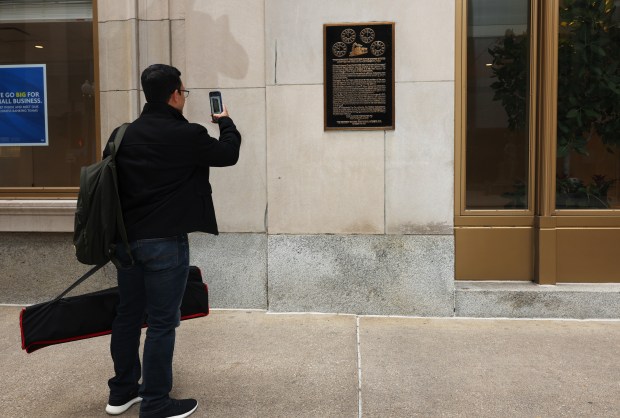 Quazi Hasan of Austin, Texas, takes a picture of a plaque commemorating the General Time Convention of 1883, where the Standard Time system was adopted, on a wall at South LaSalle Street and West Jackson Boulevard at the Central Standard Building, 231 S. LaSalle St., on Nov. 1, 2023, in Chicago. (John J. Kim/Chicago Tribune)
Quazi Hasan of Austin, Texas, takes a picture of a plaque commemorating the General Time Convention of 1883, where the Standard Time system was adopted, on a wall at South LaSalle Street and West Jackson Boulevard at the Central Standard Building, 231 S. LaSalle St., on Nov. 1, 2023, in Chicago. (John J. Kim/Chicago Tribune)
1883: The Standard Time system was adopted in Chicago. Until then, a Chicagoan asked to tell what time it was could give more than one answer and still be correct. There was local time, determined by the position of the sun at high noon at a centrally located spot in town, usually City Hall. There was also railroad time, which put Columbus, Ohio, faster than Cincinnati and faster than Chicago. Scattered across the country were 100 local time zones, and the railroads had some 53 zones of their own.
Daylight saving time: Why it began, where it exists and how it saved one Chicago man’s life
To do away with the inevitable confusion, the railroads took the matter into their own hands, holding a General Time Convention in the fall of 1883 at the Grand Pacific Hotel at LaSalle Street and Jackson Boulevard (a plaque at the location — which is just north of the Chicago Board of Trade Building — notes its significance).
Flashback: How the Great Fire of 1871 gave rise to the Chicago Public Library
1897: Chicago’s Central Library, on Michigan Avenue between Washington and Randolph streets, opened one day after its dedication ceremony. “A woman was the first one in the building, the first at the top of the stairs, and the first to make out her list and hand it to the attendant there, who handed her the first book given out from the new building,” the Tribune reported. Though the title of the first book checked out was not revealed.
The building — which includes the largest stained glass Tiffany dome in the world — has been home to the Chicago Cultural Center since 1991.
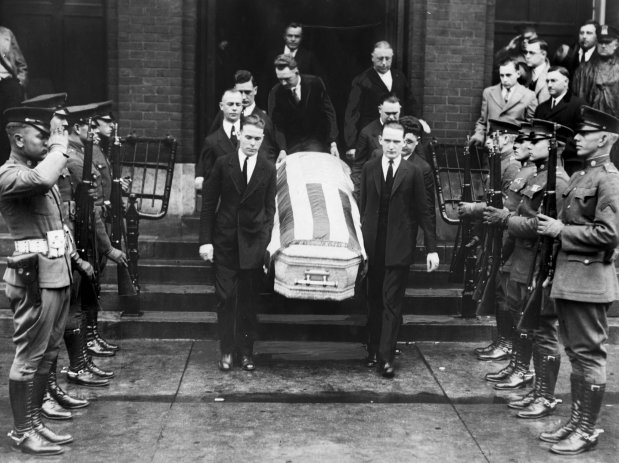 Pallbearers carry the body of Edwin Shanahan, who was shot and killed by Martin Durkin, from St. Leo’s Catholic Church at 78th Street and Emerald Avenue, while a guard of honor from the 14th cavalry stands at attention on Oct. 14, 1925. (Chicago Tribune historical photo)
Pallbearers carry the body of Edwin Shanahan, who was shot and killed by Martin Durkin, from St. Leo’s Catholic Church at 78th Street and Emerald Avenue, while a guard of honor from the 14th cavalry stands at attention on Oct. 14, 1925. (Chicago Tribune historical photo)
1925: Edwin Shanahan became the first FBI agent killed in the line of duty when he was shot to death by car thief Martin Durkin at a garage at 6231 S. Princeton Ave. in Chicago.
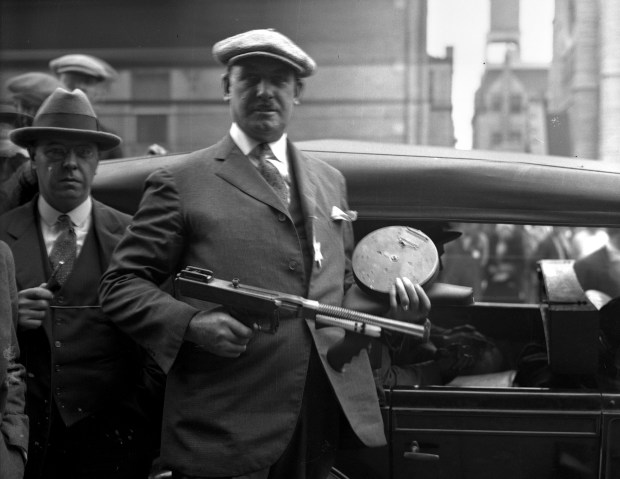 The Thompson submachine gun used to kill mob boss “Hymie” Weiss in Chicago, circa 1926. (Chicago Tribune historical photo)
The Thompson submachine gun used to kill mob boss “Hymie” Weiss in Chicago, circa 1926. (Chicago Tribune historical photo)
1926: After two failed attempts to kill Earl “Little Hymie” Weiss, Al Capone had two of his men rent a room at Superior and State streets from where they could get a clear shot at Weiss as he entered or left his headquarters above Dean O’Banion’s old flower shop across the street from Holy Name Cathedral.
The ‘Tommy gun’ was designed for soldiers. But Chicago gangsters made it notorious.
The end came for Weiss in a hail of bullets that also killed his driver Sam Peller, wounded three others of his gang and damaged the cornerstone of the cathedral. Ten days later, a peace pact was worked out between the two rival gangs at the Hotel Sherman.
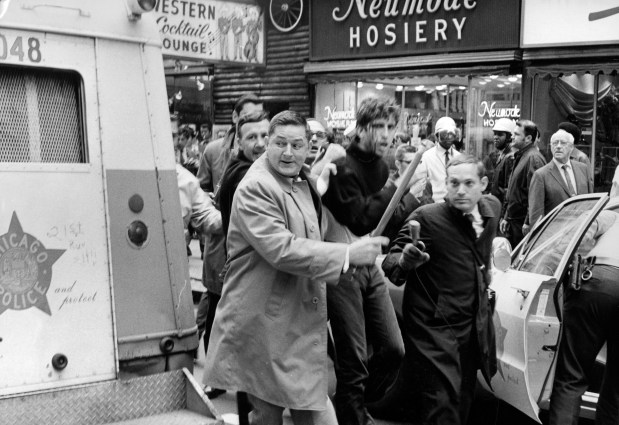 Chicago police and protesters clash at LaSalle and Madison streets on Oct. 11, 1969, during a Students for a Democratic Society march in Chicago. (Walter Kale/Chicago Tribune)
Chicago police and protesters clash at LaSalle and Madison streets on Oct. 11, 1969, during a Students for a Democratic Society march in Chicago. (Walter Kale/Chicago Tribune)
1969: The most outrageous of the Days of Rage arrived.
Hundreds of hardcore protesters gathered on Randolph Street at the site of the Haymarket Square statue of a policeman that had been damaged by a late-night explosion just five days earlier.
The National Guard has been activated to Chicago 18 times from 1877-2021. Here’s a breakdown.
Accompanied by an army of police, the marchers walked east on Randolph to LaSalle Street, where they turned south, ostensibly on a circuitous Loop march to Grant Park.
But at LaSalle and Madison streets, the demonstrators broke ranks, clashed with police and headed east on Madison, breaking store windows and fighting with police in a vicious melee that resulted in nearly 300 arrests, 48 police injuries and unknown number of protesters.
 Eve, a young chimpanzee, was taken from the Lincoln Park Zoo on Oct. 11, 1982, by three men who intended to sell her in exchange for narcotics. She was recovered Oct. 14, 1982, from an apartment on Archer Avenue. (Chicago Tribune)
Eve, a young chimpanzee, was taken from the Lincoln Park Zoo on Oct. 11, 1982, by three men who intended to sell her in exchange for narcotics. She was recovered Oct. 14, 1982, from an apartment on Archer Avenue. (Chicago Tribune)
1982: Two men — assisted by an animal keeper on leave from Lincoln Park Zoo — took Eve, a 3-year-old chimpanzee, from her cage with the intention of selling her for money to buy narcotics. She was next spotted in a car with them on South Lake Shore Drive near the Stevenson Expressway.
Tips came in saying Eve could be at a railroad yard near East Randolph Street, which prompted animal keepers and police armed with bananas to search there for her. But, no luck. Another tip led to a second-floor apartment on Archer Avenue, which housed one of the suspects.
When police arrived, they found Eve and also discovered a mess that covered portions of the ceiling and the floor. Fed only bananas by her captors, Eve experienced gastrointestinal distress. That coupled with her lack of toilet training made for quite a mess. She was returned to the zoo after four days on the run and later shared a celebration feast of apples and cake with her cagemate, Sibu.
Want more vintage Chicago?
Subscribe to the free Vintage Chicago Tribune newsletter, join our Chicagoland history Facebook group, stay current with Today in Chicago History and follow us on Instagram for more from Chicago’s past.
Have an idea for Vintage Chicago Tribune? Share it with Kori Rumore and Marianne Mather at krumore@chicagotribune.com and mmather@chicagotribune.com
